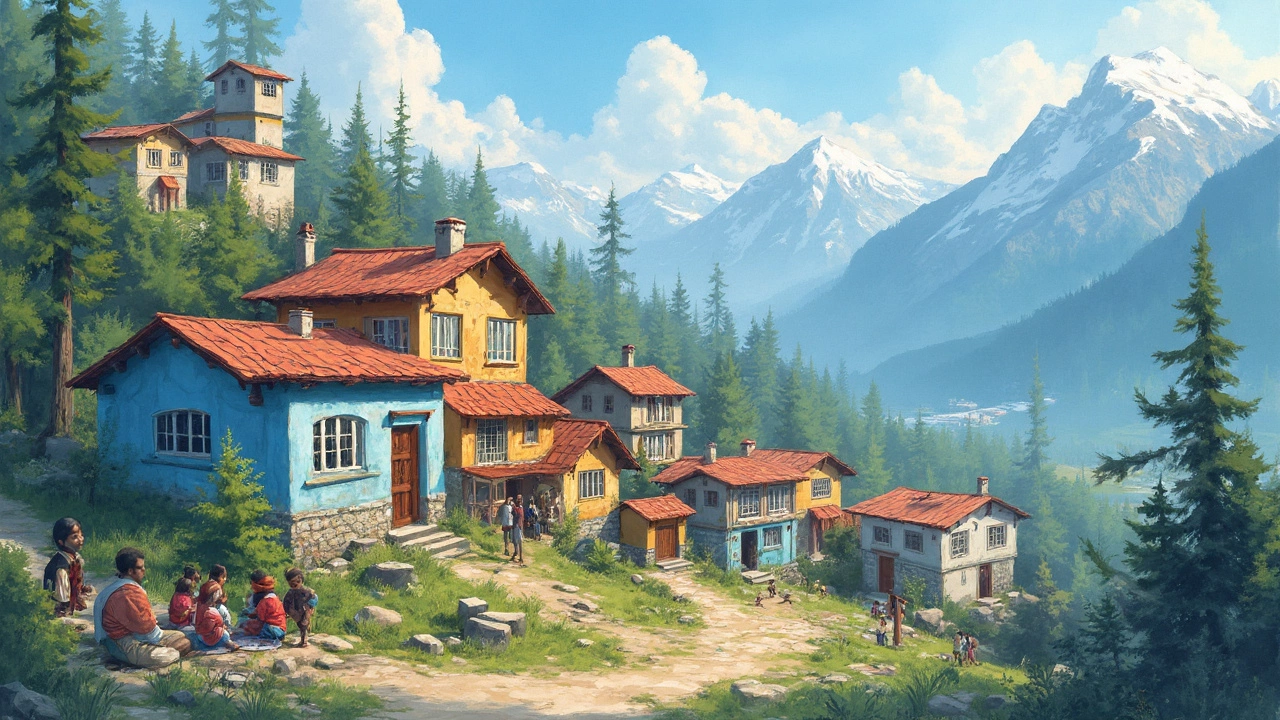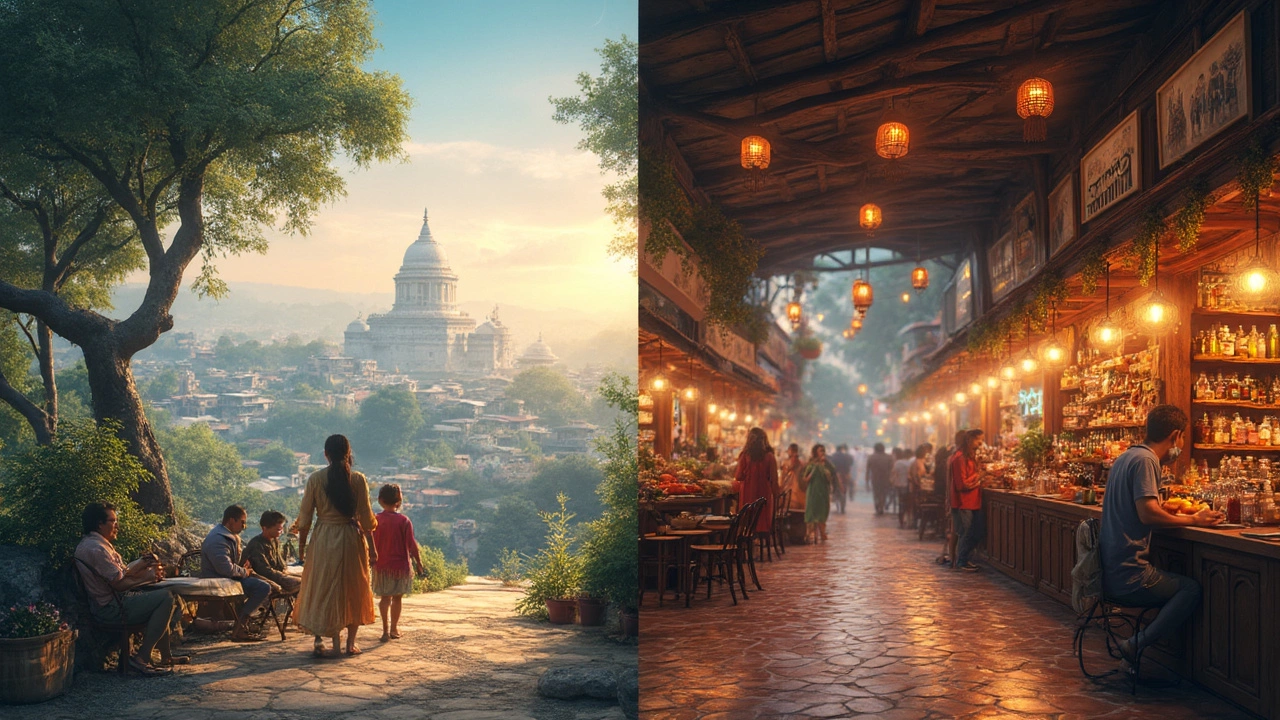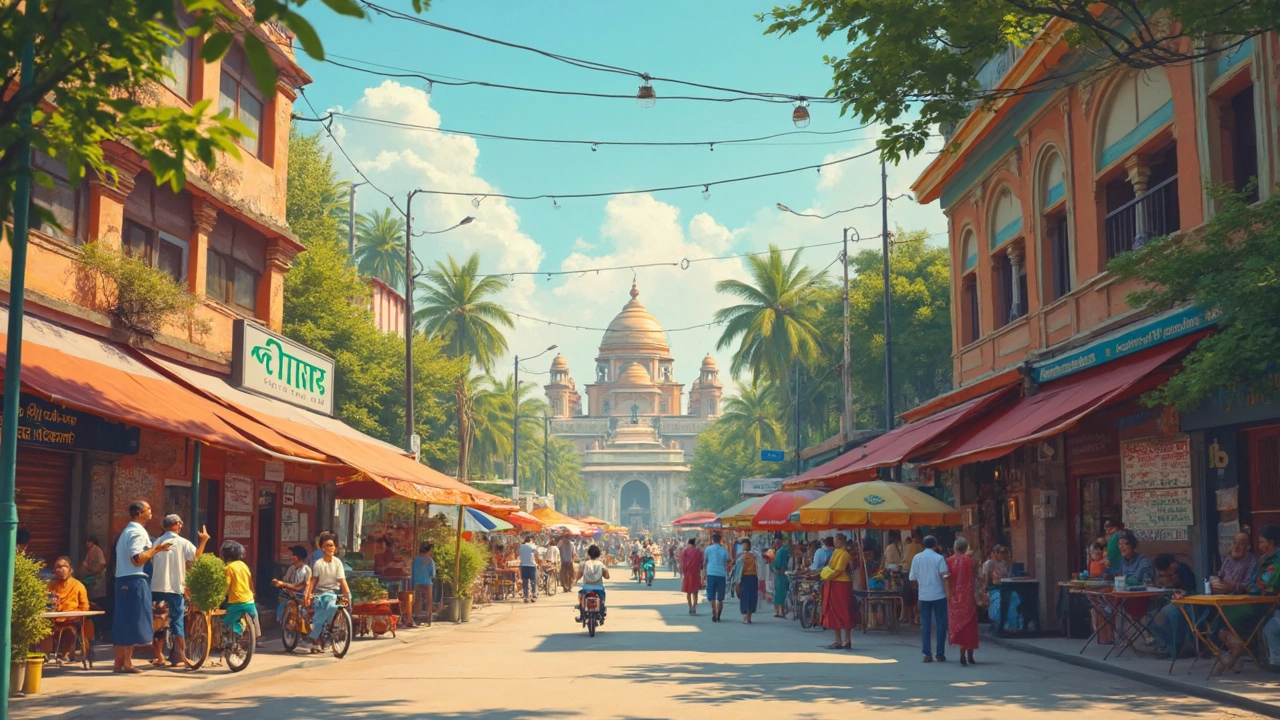If you’re thinking about settling down in North India, you’re not alone. Thousands come here dreaming of a place that’s got great weather, tasty food, and just enough peace and quiet to actually relax. But what part really nails it? North India isn’t just one thing—it’s a wild mix of mountains, vibrant cities, Dusty plains, and cultural hotspots.
Most guides toss out the same generic advice. Instead, let’s look at the real perks and weak spots. Where can you actually breathe clean air? Where does the Wi-Fi work (most of the time!)? And the big one—how expensive is that killer street food you keep hearing about?
Maybe you’re after that mountain town vibe with slow mornings and chilly air. Or perhaps you’d rather have all-night cafés, huge shopping malls, and airports that don’t shut down in the fog. No spot has it all, but a few come close. In this article, you’ll get straight facts, not tourist brochure fluff, on what life’s truly like in the nicest parts of North India. Ready to ditch the guesswork? Here’s what you need to know before you start packing your bags.
- Why North India Appeals to Residents
- Chandigarh: Urban Planning and Green Spaces
- Shimla & Manali: Mountain Town Vibes
- Jaipur: Culture and Modern Conveniences
- Lucknow & Dehradun: The Underrated Contenders
Why North India Appeals to Residents
You’ll hear it from expats, students, and families—north india checks off a bunch of boxes when it comes to a comfortable life. This region draws people who want more than just a pretty view (though there are plenty of those). Here’s what stands out when real folks decide to put down roots here.
For starters, the climate is a big deal. Unlike the sultry south or super-humid coasts, places around the Himalayas or the plains get cool winters and pleasant springs. Cities like Chandigarh, Dehradun, and Shimla let you escape brutal heatwaves while still getting loads of sunshine in winter. Locals love the fresh morning air—especially after a night of rain.
If you want to stay connected to big opportunities, it’s hard to ignore the metro links and roadways up north. Delhi, for example, is basically the country’s travel hub, letting you hop across India (and abroad) without endless layovers. Even smaller towns have new highways and fast trains that make quick trips to major cities possible. Families and students appreciate the number of schools, colleges, and big hospitals—especially in cities like Jaipur and Lucknow.
The mix of city and mountain vibes is rare anywhere else. Within a few hours, you can go from eating momos in Dharamshala to shopping in Chandigarh to chilling in Rishikesh by the Ganges. The weekend road trip has practically become a lifestyle, thanks to a web of highways and tons of quirky “dhaba” stops for tea or parathas.
Cost of living does shift a lot from city to city, but here's a quick idea for a few popular north Indian places:
| City | Avg. Rent (1 BHK, central) | Good Restaurant Meal | Internet (monthly, avg.) |
|---|---|---|---|
| Chandigarh | ₹18,000 | ₹350 | ₹700 |
| Dehradun | ₹13,000 | ₹250 | ₹650 |
| Manali | ₹10,000 | ₹200 | ₹1,000 |
| Jaipur | ₹16,000 | ₹300 | ₹800 |
| Lucknow | ₹12,000 | ₹250 | ₹700 |
Straight talk—north India’s got some solid perks for young workers, retired folks, remote freelancers, and anyone after a good mix of city buzz and nature. Daily life feels more relaxed in smaller cities, and you won’t get bored with all the historic sites, markets, and food trails. It’s easy to see why so many decide to move here and just stay put.
Chandigarh: Urban Planning and Green Spaces
Chandigarh stands out in North India for one big reason: it’s super organized. Straight roads, roundabouts that actually work, and neighborhoods (called “sectors”) that make it easy to find your way—even if your sense of direction is terrible. This isn’t an accident. Le Corbusier, a famous architect, designed the city back in the ’50s and it still looks modern compared to most Indian cities.
The first thing you notice here? Cleanliness. You won’t see huge piles of trash, and the air feels lighter. It’s one of the few large Indian cities where folks really care about rules. Traffic actually stops at signals—seriously! And most streets and parks are lined with trees, so you’re never far from shade or a green patch of grass.
The north india vibe is strong, but living in Chandigarh feels a bit different from the chaos found in other places. Families love it because schools and hospitals are top-notch. Parks are everywhere. Sukhna Lake is where the city comes to chill—mornings are full of walkers, evening boat rides are super peaceful, and the vibe is pretty wholesome.
- If you’re a food lover, the city’s got everything: dhabas, street food, and a bunch of fancy restaurants. The famous “Sector 17” market is where shopping meets evening snacks.
- Public transport is decent. Buses and autos are reliable, and it’s safe to walk or cycle around, even late in the evening.
- If you work online, the Wi-Fi in major sectors usually holds up well. Co-working spaces have popped up recently, so freelancers don’t feel out of place.
One thing to keep in mind: compared to smaller towns, living here is pricier. Rent and eating out will stretch your budget a bit if you’re just starting out. But if you want a clean, green, and well-planned home base with quick access to both Delhi and the hills, Chandigarh’s a top pick.

Shimla & Manali: Mountain Town Vibes
If clean air and a daily dose of mountain views sound good, Shimla and Manali are top choices in north india. Both these towns are famous for their easy-going pace, cooler climate, and some of the friendliest people you’ll meet. Locals don’t shy away from sharing their love for maggi noodles by the roadside or stories about last year’s snowfall.
Let’s break down the strengths and weak spots of each place:
- Shimla: As Himachal Pradesh’s capital, Shimla gets busy in summer but offers public facilities, regular buses, and tons of walkable areas. Mall Road is great for shopping or just people-watching. Expect old British-era buildings you can’t miss. You get easy access to schools and hospitals, which is a win if you plan to stay long term.
- Manali: More chilled and surrounded by apple orchards. Manali draws more digital nomads and young backpackers than retirees, but families live here too. It’s a hotspot for adventure sports like paragliding and river rafting. Cafés run by locals and expats whip out fresh coffee and high-speed Wi-Fi—at least when the power’s not out. Winters are snowy. Seriously snowy.
For daily life, here’s what you’re looking at:
| City | Altitude (meters) | Avg Rent (2BHK, ₹/month) | Winter Avg Temp (°C) | Internet Speed (Mbps, avg.) |
|---|---|---|---|---|
| Shimla | 2,276 | 18,000 | 2-8 | 23 |
| Manali | 2,050 | 14,000 | -4 to 6 | 18 |
If you work online, keep in mind that power cuts can happen, especially in harsh winters. So, having backup internet (think mobile data) saves the day. Cost-wise, groceries might be a bit pricier than in plains, but you gain on rent compared to Delhi or Bangalore.
What really sets these towns apart? The sense of community is strong. You’re likely to know your corner shop owner by name within a couple of weeks. Festival times get lively, with everyone—locals and expats—pitching in for public events. If you love short treks, live music by local bands, or simply sipping chai with a mountain view, you’ll fit right in.
For families, both towns have a range of schools (including some well-known boarding schools in Shimla) and reasonable healthcare. Those with asthma or respiratory allergies find the fresh air a huge relief compared to bigger cities. But if you hate cold winters, you’ll want to bring seriously warm clothes or rethink your choices.
Jaipur: Culture and Modern Conveniences
Jaipur is where old meets new. This city stands out in North India if you want buzzing markets, real culture, and modern comforts without blowing your budget. The streets are packed, but you never go bored—there’s always something happening.
Jaipur isn’t just for visitors chasing forts and palaces. People actually live well here. The city’s planned layout makes it easier to get around compared to other North Indian cities (looking at you, Delhi traffic). The Pink City tag isn’t just hype; the main buildings in the old city really are painted in shades of pink, keeping the vibe unique. Plus, the food scene is its own thing—between spicy pyaaz kachori, creamy lassi, and year-round snacks sold by local vendors, you won’t wonder what to eat next.
Let’s talk numbers. Jaipur is much cheaper than most metros. You can rent a decent 2BHK apartment in a good area for less than ₹20,000 per month. Daily commute? Ola and Uber run strong, and the Jaipur Metro keeps expanding. Wi-Fi speeds are steady in the center, and power cuts rarely happen now thanks to improved infrastructure.
| Living Costs Snapshot (2025) | Price (₹) |
|---|---|
| 2BHK Apartment (City Center, Monthly) | 18,000 |
| Meal at Mid-Range Restaurant | 600 |
| Local Transport (Monthly Pass) | 1,200 |
| Basic Utilities (Electricity, Water, Gas, Internet) | 3,500 |
Safety is pretty good, especially in main neighbourhoods. People are friendly and helpful—it feels less anonymous than bigger cities. Expats and students blend right in, especially around Bani Park and C-Scheme. Most shops accept digital payments, and you’ll find swanky malls like World Trade Park for when you need AC and global brands.
If you like events and heritage, Jaipur comes alive during festivals. Don’t miss the Jaipur Literature Festival if you’re bookish, or the kite festival in January if you want something fun outdoors. Here’s a pro tip: weekends are best spent at Nahargarh Fort for sunset views, or clubbing in newer parts of town like Tonk Road.
Bottom line: if your checklist is north india comfort, food, and culture with just enough modern perks, Jaipur makes everyday living both lively and easy.

Lucknow & Dehradun: The Underrated Contenders
Most folks box Lucknow and Dehradun into categories like “good for short trips” or “nice for retirees.” Truth is, both are pulling lots of young professionals and families who want something different from the usual big north Indian cities. You won’t see wild rent prices like in Delhi, and there’s a big bonus—less chaos, lots more character.
Let’s get into the nitty-gritty. Lucknow, the capital of Uttar Pradesh, is famous for that mouthwatering Awadhi food, big green parks, and a historic vibe without the overdone tourist crowds. Dehradun, on the other hand, is more chill—think clean air, mountains on the horizon, and tons of famous schools and research centers. Both cities score high on livability, and here’s why:
- Best places to live in North India often means a balance between affordability, access, and safety. Lucknow and Dehradun both tick those boxes.
- Rent in a good Lucknow neighborhood, like Gomti Nagar, usually starts around INR 10,000/month for a decent 1BHK. Dehradun offers 1BHKs for INR 8,000–12,000 in well-connected spots like Rajpur Road.
- Transport is reliable—Lucknow has metro service and decent app cabs; Dehradun relies on shared autos, buses, and there’s an airport only 30 km out.
- Healthcare in both cities is surprisingly solid. Lucknow is known for SGPGI Hospital, and Dehradun’s Max and Fortis hospitals are top picks.
| Factor | Lucknow | Dehradun |
|---|---|---|
| Monthly 1BHK Rent | INR 10,000–15,000 | INR 8,000–12,000 |
| Average Air Quality Index | 140 (Moderate) | 75 (Good) |
| Major Public Transport | Metro, buses, cabs | Buses, shared autos |
| Top Schools | City Montessori, La Martiniere | Doon School, Welham’s |
| Nearest Airport | 12 km from city | 30 km from city |
Foodies can’t go wrong in Lucknow. Kebabs, biryanis, chaats—the quality’s on another level. In Dehradun, it’s more about cozy cafés, crunchy momos, and local bakeries. For families, both places offer top schools and a healthier pace of life without the scramble of bigger cities.
Safety? Both cities rate above average for women’s safety compared to most large Indian cities. Still, usual big city precautions apply. Crime rates here are lower—local police data shows petty theft is more common than serious stuff.
One thing to consider: Lucknow’s summers get roasting, easily hitting 43°C in June. Dehradun is milder, especially in evening hours, so heat is less of a worry. Pollution in Lucknow is a concern, but Dehradun’s clear mountain air wins, especially if you spend a lot of time outdoors.
As a local realtor from Dehradun put it,
“People come here for the schools and the weather, but they stay for the calm. Dehradun feels like a small town, but you don’t ever feel stuck or bored.”
If you’re looking for a quality life, good schools, lower living costs, and the right mix of modern and traditional, Lucknow and Dehradun deserve a spot at the top of your North India list.
